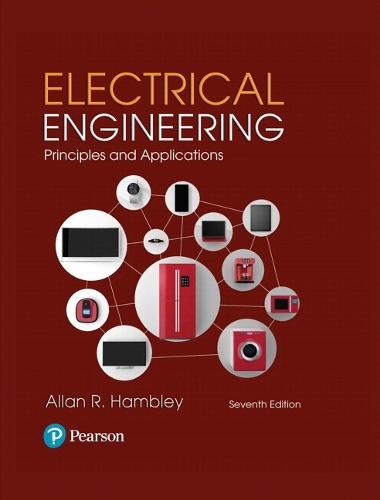Overview
For courses in Electrical Engineering. Accessible and applicable learning in electrical engineering for introductory and non-major courses The #1 title in its market, Electrical Engineering: Principles and Applications helps students learn electrical-engineering fundamentals with minimal frustration. Its goals are to present basic concepts in a general setting, to show students how the principles of electrical engineering apply to specific problems in their own fields, and to enhance the overall learning process. This book covers circuit analysis, digital systems, electronics, and electromechanics at a level appropriate for either electrical-engineering students in an introductory course or non-majors in a survey course. A wide variety of pedagogical features stimulate student interest and engender awareness of the material’s relevance to their chosen profession. The only essential prerequisites are basic physics and single-variable calculus. The 7th Edition features technology and content updates throughout the text. Also available with Mastering Engineering Mastering™ Engineering is an online homework, tutorial, and assessment program designed to work with this text to engage students and improve results. Interactive, self-paced tutorials provide individualized coaching to help students stay on track. With a wide range of activities available, students can actively learn, understand, and retain even the most difficult concepts. The text and Mastering Engineering work together to guide students through engineering concepts with a multi-step approach to problems. Note: You are purchasing a standalone product; MyLab™ & Mastering™ does not come packaged with this content. Students, if interested in purchasing this title with MyLab & Mastering, ask your instructor for the correct package ISBN and Course ID. Instructors, contact your Pearson representative for more information. If you would like to purchase both the physical text and MyLab & Mastering, search for: 0134712870 / 9780134712871 Electrical Engineering: Principles & Applications Plus Mastering Engineering with Pearson eText -- Access Card Package, 7/e Package consists of: 0134484142/9780134484143 Electrical Engineering: Principles & Applications 0134486978 / 9780134486970 Mastering Engineering with Pearson eText -- Standalone Access Card -- for Electrical Engineering: Principles & Applications
Full Product Details
Author: Allan Hambley
Publisher: Pearson Education (US)
Imprint: Pearson
Edition: 7th edition
Dimensions:
Width: 21.00cm
, Height: 3.00cm
, Length: 26.00cm
Weight: 1.585kg
ISBN: 9780134484143
ISBN 10: 0134484142
Pages: 896
Publication Date: 01 March 2017
Audience:
College/higher education
,
Tertiary & Higher Education
Replaced By: 9780273793250
Format: Hardback
Publisher's Status: Active
Availability: Available To Order

We have confirmation that this item is in stock with the supplier. It will be ordered in for you and dispatched immediately.
Author Information
Allan R. Hambley received his B.S. degree from Michigan Technological University, his M.S. degree from Illinois Institute of Technology, and his Ph.D. from Worcester Polytechnic Institute. He has worked in industry for Hazeltine Research Inc., Warwick Electronics, and Harris Government Systems. He is currently Professor of Electrical Engineering at Michigan Tech. The Michigan Tech chapter of Eta Kappa Nu named him the Outstanding Electrical Engineering Teacher of the Year in 1995. He has won the National Technological University Outstanding Instructor Award six times for his courses in communication systems. The American Society for Engineering Education presented him with the 1998 Meriam Wiley Distinguished Author Award for the first edition of his book, Electronics. His hobbies include fishing, boating in remote areas of Lake Superior, and gardening.



